The Problems With Nursery-Bought Plants, And The Solutions
October 8th, 2024 by Alex Zorach
Over the past several decades, we have seen a shift towards management-intensive landscapes, meaning that progressively less and less of our environment is taken up by wild or semi-wild ecosystems, and more is maintained as landscaping, including lawns, planted trees and shrubs, and manicured flower beds. The landscaping in this photo shows a mix of trees, shrubs, and herbaceous plants. Although lush and green, it is entirely managed and has no wild components. Even the lawn is a monoculture of a single grass type. Such managed landscapes are taking up an increasing portion of the land in our society, which is a cause for alarm both as it leaves fewer places for wild plants to reproduce, and because such landscapes require considerable resources to maintain. Photo © Warren LeMay, CC BY-SA 2.0, Source.
The landscaping in this photo shows a mix of trees, shrubs, and herbaceous plants. Although lush and green, it is entirely managed and has no wild components. Even the lawn is a monoculture of a single grass type. Such managed landscapes are taking up an increasing portion of the land in our society, which is a cause for alarm both as it leaves fewer places for wild plants to reproduce, and because such landscapes require considerable resources to maintain. Photo © Warren LeMay, CC BY-SA 2.0, Source.With few exceptions, plants in managed landscapes are purchased at commercial nurseries. Retail nurseries are the final point in a supply chain that also includes wholesale nurseries and growers that produce plants, as well as horticulturalists and the organizations that employ them, breeding and testing various plants. Wholesale nurseries also supply plants for the plant sales of non-profit organizations such as universities, conservation organizations, national organizations like the Arbor Day Foundation and local municipalities that give away trees, and also ecological restoration projects and other large-scale plantings like roadside projects for erosion control, land reclamation, and reforestation. Some of these plants get planted in managed landscapes and others go directly into the wild.
Between the direct restoration plantings, and the offspring of plants seeding out into wild ecosystems, an increasing portion of wild ecosystems is made up of plants either sourced through this supply chain, or descended from such plants.
The effect of this industry on our environment has been far more negative than positive. In this post we outline two of the main causes of harm: the introduction of invasive plants through breeding, production, distribution, and sale of exotic plants, and the widespread planting of non-local stock of native plants, often erasing and overwriting local population genetics. Our post also outlines solutions. We show how the horticulture industry can embrace a new approach that protects local wild populations and their unique genetics while also being lucrative for the industry and creating good jobs. We also show how, in the meanwhile, gardeners and people doing ecological restoration work can grow and source plants without relying on the nursery industry's broken supply chain.
How has the ornamental plant industry caused harm?
Introduction of Invasive Species
An overwhelming majority of the worst invasive plants in North America were intentionally introduced as landscaping plants. Our analysis of the 96 species on the Delaware Invasive Species Council's Invasive Plant List found that 67 of them, about 70%, originated as ornamental or landscaping plants, and only 7 of these ornamentals also had other uses such as food or fodder. Ornamentals (70%) are a much greater source of invasive introduction than other sources, such as accidental introduction (22%), food plants (11%), or other intentional uses (7%). (These figures add to more than 100% because some plants had multiple paths of introduction.)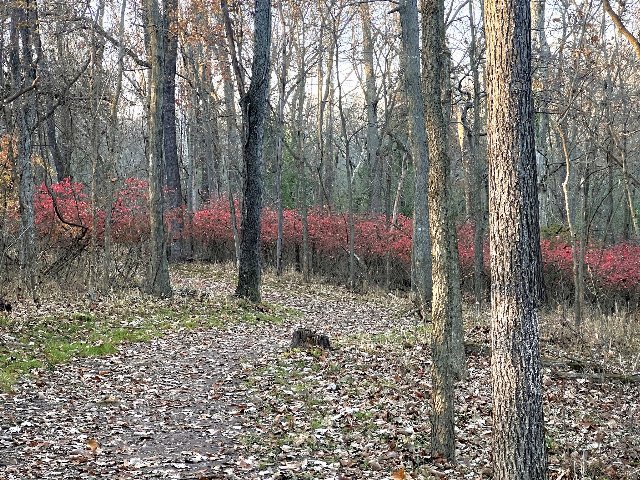 Burning bush (Euonymus alatus) was widely planted in North America as an ornamental, valued for its bold red fall color. It is one of many ornamental plants that became invasive. Here it is dominating the understory in a forest in Springfield, Missouri, shutting out nearly all native woody plants. Photo © Nathan Aaron, CC BY 4.0, Source.
Burning bush (Euonymus alatus) was widely planted in North America as an ornamental, valued for its bold red fall color. It is one of many ornamental plants that became invasive. Here it is dominating the understory in a forest in Springfield, Missouri, shutting out nearly all native woody plants. Photo © Nathan Aaron, CC BY 4.0, Source.Continent-wide, the list of invasive plants introduced as ornamentals includes trees such as tree of heaven (Ailanthus altissima) and Norway maple (Acer platanoides), shrubs such as amur honeysuckle (Lonicera maackii) and chinese privet (Ligustrum sinense), vines such as Japanese honeysuckle (Lonicera japonica) and porcelain berry (Ampelopsis glandulosa), and numerous smaller plants such as lesser celandine (Ranunculus ficaria), purple loosestrife (Lythrum salicaria), butter and eggs (Linaria vulgaris), or common iceplant (Mesembryanthemum crystallinum). Many invasive plants cause collapse of the food web because they tend not to be eaten by as many native specialist insects; some can cause other problems, such as how iceplant causes slumping and other soil erosion, or the introduced honeysuckles can worsen deer over-browsing. All of them directly compete with, and thus threaten populations of native plants, and they tend to replace highly diverse communities and replace them with monocultures or at least less-diverse plant communities.
These plants were actively bred, marketed and promoted, and then sold and widely planted, leading to their establishment at various locations across North America. From gardens they escaped into the wild, and their wide planting made it extraordinarily difficult if not impossible to remove them from the wild once they had established.
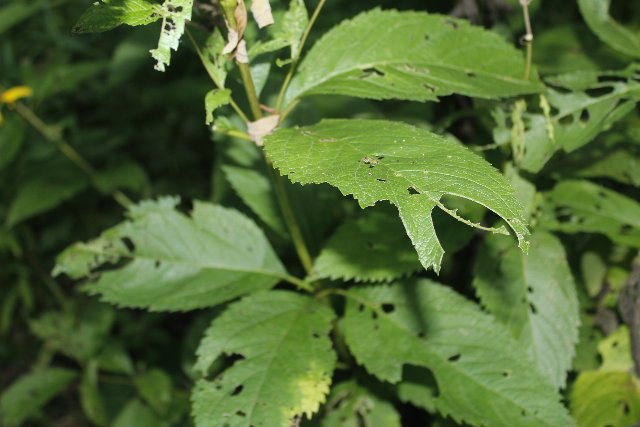 This wild spotted Joe Pye weed (Eutrochium maculatum) plant in Cattaraugus County, NY, where it is native, shows extensive insect damage. Native plants benefit ecosystems in part by supporting more insect herbivores. The process of breeding plants to select for insect resistance makes it more likely that the plants will become invasive. Photo © Alex Karasoulos, CC BY 4.0, Source.
This wild spotted Joe Pye weed (Eutrochium maculatum) plant in Cattaraugus County, NY, where it is native, shows extensive insect damage. Native plants benefit ecosystems in part by supporting more insect herbivores. The process of breeding plants to select for insect resistance makes it more likely that the plants will become invasive. Photo © Alex Karasoulos, CC BY 4.0, Source.The breeding likely contributed to these plants' invasiveness. The horticulture industry tends to select for traits such as climate hardiness, insect resistance, ease of propagation, and ability to survive in a range of conditions with little care. The selection for insect resistance increases the likelihood both that a plant will have a competitive advantage in the wild, and that it will lead to food web collapse if it does become invasive. The other traits contribute to invasiveness by increasing a plant's fitness in a new region.
Furthermore, when developing cultivars, horticulturalists often cross-breed plants from different sources throughout the plant's native range in order to access a greater pool of genetic diversity to work with. This process alone often increases the plant's vigor and thus its potential to become invasive.
Wilson et. al. (2009) outline how biological invasions tend to involve multiple introductions from multiple sources to multiple locations, and genetic diversity is a key mediator of this effect. The breeding of ornamental plants and widespread planting of these plants thus directly plays into both of these factors, by sourcing plants from different portions of their native ranges, and then planting them in many different locations. On top of this, the selection for insect resistance, hardiness on this continent, and ease of propagation all directly increase the likelihood of invasiveness. The industry is engaging in nearly all of the behaviors that would be expected to make these plants invasive. I do not think it an exaggeration to say that this industry has created most of our invasive plants.
Selling of Plants Poorly Adapted to Their Environment
The problem of creating invasives is at one end of the spectrum; it can be seen as what results when people select exotic plants that grow "too well". However it is not intentional, and the same industry can also err in the other direction, breeding, producing and/or selling plants that do not grow well-enough.Horticulture develops, promote, and sells plants with little to no regard for the unique habitat preferences of particular plants. In many respects, it is the opposite of our approach of thinking more deeply about habitat. The lack of focus on habitat is why most gardening sources will tell you to grow everything in "moist, well-drained soil", generic conditions in which just about any plant would survive. But not every site is ideal; to the contrary, a majority of sites have some type of adverse conditions.
For example, in regions with drought-prone coarse, sandy soils, such as the outermost portions of Long Island, nurseries sell all the same plants as in regions with richer soils, and people's landscaping looks stunted as a result. In some cases, the poorly-adapted plants will look okay for many years, only to become stressed and/or die suddenly in a year with more extreme weather.
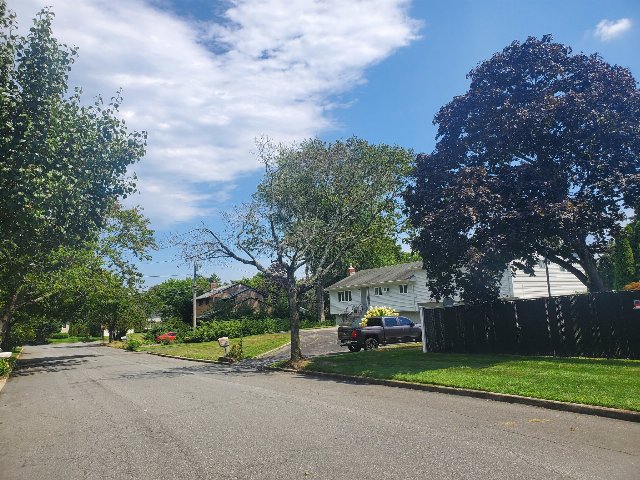 Sights like this dead street tree in Commack, NY are common on the portion of Long Island with coarse, sandy soils, the Cape Cod/Long Island ecoregion in our scheme. Note also that the other trees tend to be short and somewhat sparse. This sickly landscaping is a direct result of nurseries selling the same generic plants here they sell everywhere. If they instead sold drought-tolerant species adapted to these soils, such as pitch pine (Pinus rigida), chestnut oak (Quercus montana), white oak (Quercus alba), and black oak (Quercus velutina), especially from local stock, the trees would be healthier. Photo by Alex Zorach, CC BY-SA 4.0.
Sights like this dead street tree in Commack, NY are common on the portion of Long Island with coarse, sandy soils, the Cape Cod/Long Island ecoregion in our scheme. Note also that the other trees tend to be short and somewhat sparse. This sickly landscaping is a direct result of nurseries selling the same generic plants here they sell everywhere. If they instead sold drought-tolerant species adapted to these soils, such as pitch pine (Pinus rigida), chestnut oak (Quercus montana), white oak (Quercus alba), and black oak (Quercus velutina), especially from local stock, the trees would be healthier. Photo by Alex Zorach, CC BY-SA 4.0.Not only does this phenomenon lead to stunted plants, it drives a lot of resource usage as people pour money and effort into irrigation, soil enrichment, or even importing new soil. In the West, such wasteful water usage worsens already-severe problems like depleted aquifers or the fact that the U.S. has used up nearly all the water in the Colorado River before it reaches its delta, which has devastated the delta's ecosystems and also devastated the fishing industry in the Gulf of California. Stressed plants growing on unsuitable sites can also create costly accidents, especially with trees, which can fall on buildings, vehicles, or even injure people.
The phenomenon of nurseries selling the same generic plants everywhere has worsened in the past 3 or so decades, as the US and Canada have both experienced a consolidation of retail establishments into regional, national, or multinational box stores. Not only have smaller businesses closed and been replaced by larger ones, but there has been a shift away from specialty retailers and towards generic ones. Nowadays, a huge portion of plants are not sold at proper plant nurseries, but rather, at generic retailers such as Home Depot, Lowe's, or even Wal-Mart, that have nursery departments or sections. With these consolidations, knowledge and expertise relevant to local conditions has been lost. There is also an economic loss: higher-skill, higher-pay jobs get replaced by lower-skill, lower-pay jobs in a "race to the bottom", where companies derive profits primarily by cutting costs.
Erasing and Overwriting Local Genetics of Native Plants
Some plants have vast native ranges, and within these ranges, the genetics of plants can be quite different from one portion of its range to another. The different forms adapted to particular conditions are called ecotypes. Ecotypes are sometimes recognized as sub-taxa such as varieties or subspecies. In most cases, no subtaxa are recognized, but the genetic diversity and variability of form that is associated with adaptation to local conditions is still present. In these cases, the variation forms a continual intergrade rather than being able to be broken cleanly into separate groups.Long before I studied ecotypes, I had noticed that when people take an individual plant across long distances and plant it elsewhere, it often does not do as well as the local plants of the same species. For example, when I was a young child, my parents had transplanted an American holly (Ilex opaca) tree from my grandparents' yard in Arkansas, planting it in Lancaster, Pennsylvania, and it always struggled. Its leaves were yellower, it grew slowly, and it never looked as lush or healthy as other hollies. But volunteer hollies came up in our yard, and they grew faster, kept consistently green leaves, and grew lush and full. One such tree, much younger than the Arkansas-sourced holly, eventually overtopped the much-older Arkansas tree, and has continued to grow taller. It is pictured below.
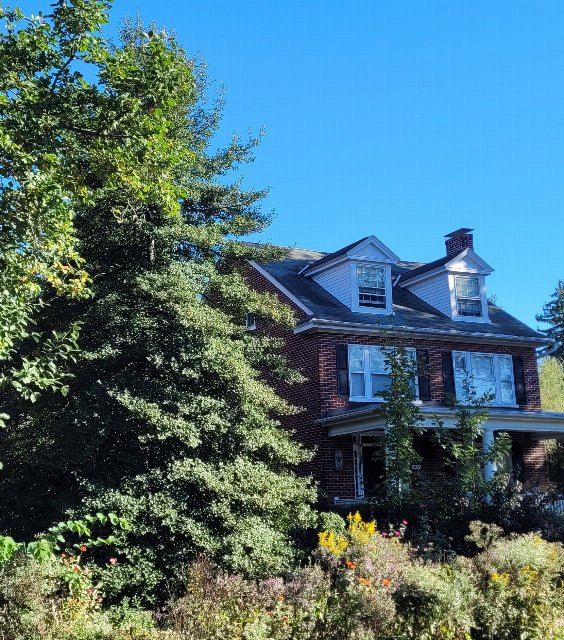 This garden in Lancaster, PA shows landscaping utilizing volunteer plants. The large American holly (Ilex opaca), as well as the two saplings on the right, a sugar maple (Acer saccharum) and a northern red oak (Quercus rubra), and the eastern redbud (Cercis canadensis) on the left were all volunteers, as were the tall goldenrod (Solidago altissima) and frost aster (Symphyotrichum pilosum) in the bed in the foreground. This landscape is managed, in that unwanted plants are removed and plants are pruned, but wild plants are still allowed to reproduce from seed here, and actually make up the bulk of the biomass. Nursery-grown plants are only used as accents. Photo © Cecile Zorach, CC BY 4.0.
This garden in Lancaster, PA shows landscaping utilizing volunteer plants. The large American holly (Ilex opaca), as well as the two saplings on the right, a sugar maple (Acer saccharum) and a northern red oak (Quercus rubra), and the eastern redbud (Cercis canadensis) on the left were all volunteers, as were the tall goldenrod (Solidago altissima) and frost aster (Symphyotrichum pilosum) in the bed in the foreground. This landscape is managed, in that unwanted plants are removed and plants are pruned, but wild plants are still allowed to reproduce from seed here, and actually make up the bulk of the biomass. Nursery-grown plants are only used as accents. Photo © Cecile Zorach, CC BY 4.0.I also noticed that, much of the time, wild volunteer plants grew more vigorously than nursery-bought plants of the same species. This sparked me to wonder if part of the reason why the nursery plants were growing so poorly was that they were not derived from local populations, and thus not adapted to the local soil or climate conditions.
So I began asking nurseries where their stock was derived from, and I found that, an overwhelming majority of times they just didn't know. I'd talk to a manager or owner, and they wouldn't know either. In some cases they referred me to their supplier, a wholesaler, and after networking and talking to people working for several different wholesalers, I came to the conclusion that the suppliers didn't know either. People in the wholesale nursery industry generously took their time to explain to me about how the supply chain for the nursery industry worked, and I was shocked to find that almost no one kept any records about which plant populations their stock was derived from. Rather, growers would just breed certain lines of plants and then sell them, and there was minimal information about the origins of the various lineages.
Many of these lineages have been isolated from wild populations for generations now, and selected for traits such as insect resistance and propagation in a nursery setting. Even Mt. Cuba Center, often hailed as a leader in the native plant movement, suffers from this approach. Although Mt. Cuba makes sure their plants provide value to the food web through functioning as insect food, their trial garden still tests plants only in a typical garden setting, meaning a mulch bed in more-or-less mesic conditions (moist and well-drained.) Plants adapted to other conditions are given a lower score if they perform poorly in test plots, even if they thrive in the more naturalistic gardens elsewhere on the grounds. Plant breeders are often selecting for similar characteristics, and thus may breed out the traits that make plants adapted to their unique habitat in the wild.
When people buy and plant nursery-grown plants, whether in their yards or gardens, or in ecological restoration projects, they are adding genetics which have three features:
- The source population(s) are unknown.
- Multiple source populations, perhaps far apart, may have been interbred to produce the line.
- The plants have been selected, often over many generations, for horticultural attributes.
How Nurseries Can Fix These Problems
The problems discussed above are fully solvable, but they require a rethinking of the way the ornamental plant trade works. The goal is for nurseries to sell only locally-native plants, derived from local, wild populations. However, getting to this point is a challenge, because it requires a fundamental rethinking and restructuring of the wholesale part of the supply chain.Selling Only Locally-Native Plants
There are no objective reasons why commercial nurseries ever need to grow introduced plants for landscaping. North America has incredible plant biodiversity. In a particular place, there are hundreds and sometimes thousands of locally-native plant species to choose from. The first change that needs to happen is an end to the importing and breeding of introduced plants for landscaping. This change includes the importing of plants onto other continents, which is the source of the most severe invasive plants, but it also includes the moving of plant material around regionally, which can still create problems, even if it is less likely to cause as severe problems.Sourcing Plants From Local Wild Populations
Sourcing local ecotype plants can be tricky, but also fun. I have been doing it myself for many years now. There are nearly endless ways to source local wild plants in ways that are both legal and environmentally-responsible, including:- Isolated rescue plants, such as plants that have seeded into areas where they are going to die if not transplanted. In my experience, most property owners and land managers are happy to give me permission to remove any plant they see as a "weed".
- Large-scale rescue plants, such as plants from a site that is going to be developed or disturbed in such a way that will kill the plants. In this case you can sometimes transplant all of the plants, or harvest all or most of the seed, without causing any harm.
- Responsible seed harvest from a local wild population. In this case, you harvest seed from a thriving population, you take only a negligible portion of the total seed, and you ensure that you are the only one harvesting the seed so that you do not end up taking too much seed in combination with other harvesters.
- Stewardship to protect populations of plants you are harvesting seed from; for example, if you are worried that seed harvesting might reduce the numbers in a population, you can pair the harvest with control of invasive plants in the area where the plants are growing so that you gather seed while also boosting the plant's numbers. If done well, you will actually increase the plant's numbers, to where you can safely harvest more in subsequent years.
- Propagation of plants in gardens or landscaping, either vegetatively or by seed, that were derived from local wild populations. In these cases you can harvest seeds or transplant plants without causing harm to the wild populations, yet while accessing these populations' genetics.
Growing The Plants
The best solution for a supply chain producing locally-derived plants is for the production to become decentralized, with small, local growers in each region, each of whom only grow plants from wild populations native to their area.This solution eliminates the costly and cumbersome recordkeeping tasks, as each grower will only be growing stock sourced locally from near their site. This approach also eliminates the problem of escape of non-local genetic material or mixing of material from different populations, a problem that is essentially impossible to solve if growing plants outdoors, and that can still be costly and imperfect in a greenhouse environment.
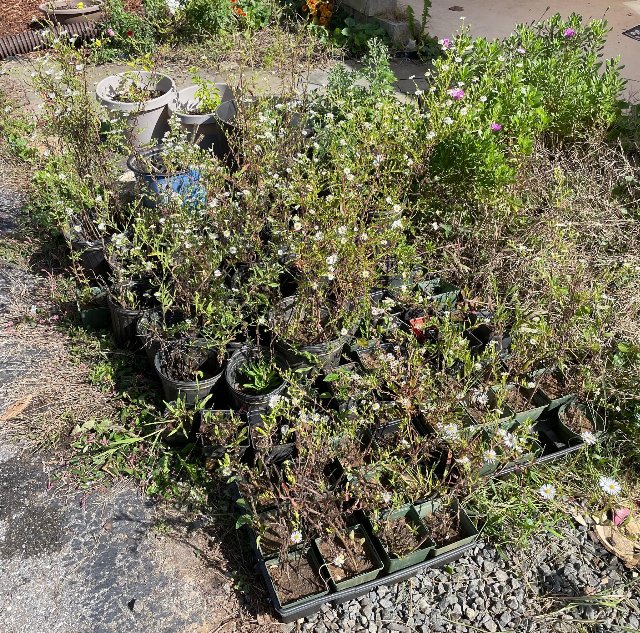 Operations to propagate native plants can be small, and need to be if we are to achieve a hyper-local focus that preserves local plant genetics. Here, Leah Brooks is propagating and growing local ecotype frost aster (Symphyotrichum pilosum) in New Castle County, Delaware, which she supplies to numerous planting projects nearby. Photo © Leah Brooks, CC BY 4.0.
Operations to propagate native plants can be small, and need to be if we are to achieve a hyper-local focus that preserves local plant genetics. Here, Leah Brooks is propagating and growing local ecotype frost aster (Symphyotrichum pilosum) in New Castle County, Delaware, which she supplies to numerous planting projects nearby. Photo © Leah Brooks, CC BY 4.0.There will likely be some cost and lost efficiency relative to the current model of large-scale wholesale nurseries, but this loss may be offset by gains in vigor and ease of growing plants. If growing plants in the climate conditions they are adapted to, they will take less care. Shipping costs will also be greatly reduced. Healthier plants and shorter shipping distance may reduce the amount of plants that die before being purchased. The plants may also command a higher price, reflecting both vigor and environmental benefits.
Furthermore, the movement to raise awareness of the need for this new approach, will itself be a form of marketing and PR to help the public see the added value in the plants produced through this hyper-local method. This blog post is not only a call to action for change within the nursery industry, but it is the first step in the marketing and PR that will create the demand and willingness to pay a higher price for plants produced in this way. And the public will benefit through purchasing healthier plants that grow faster and are longer-lived and more resistant to stressors. People may even save money, if they pay more for plants but those plants are less likely to die and need to be replaced.
Business Models To Produce Plants From Local Stock
There are different business models that could make this approach possible. One would be for conservation organizations that buy wholesale plants, either for their own plantings, or for native plant sales, to source plants from their own grounds and then hire contract growers to produce the plants. For example, the Delaware Nature Society both owns nature preserves with wild populations of plants, and has its own native plant sale, but it currently lacks the capacity to grow enough plants to meet the demand at its own plant sale. However, DNS could source seeds and/or plants from its preserves, contract a grower to grow them to a suitable size for retail sale, and then sell these plants at their plant sale.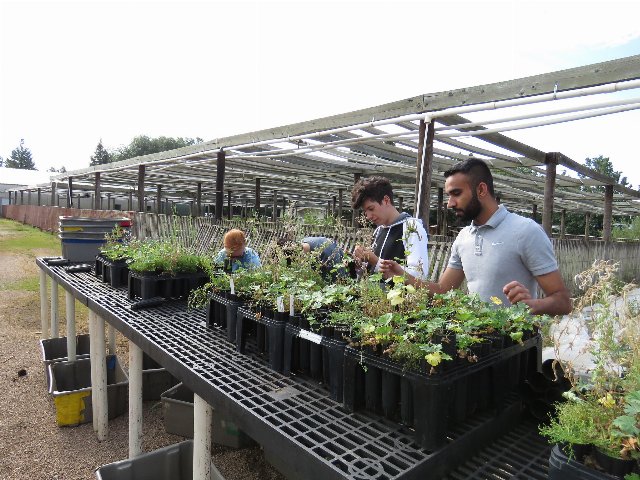 The Colorado State Forest Service maintains its own production nursery, producing stock for its own restoration plantings. This program relies on a combination of state funding, donors, and volunteer labor. This setup is only one of many possible models for local production of plants. Photo © Colorado State Forest Service, Public Domain, Source.
The Colorado State Forest Service maintains its own production nursery, producing stock for its own restoration plantings. This program relies on a combination of state funding, donors, and volunteer labor. This setup is only one of many possible models for local production of plants. Photo © Colorado State Forest Service, Public Domain, Source.A different model would be for an independent small grower to produce plants and then they could sell them to any number of retailers, whether commercial retail nurseries, local native plant sales, or large-scale ecological restoration projects.
Yet another model would be for retail nurseries and/or organizations doing ecological restoration work to grow and propagate plants themselves. Although we do not know if they still do it, back around 2012, Bartram's Garden in Philadelphia propagated some of the plants both for their own native plant sale and for their gardens and surrounding wild habitats. A newer retail nursery has opened in Bainbridge, PA, Hungry Hook Farms, focused on seed-grown plants from local ecotypes in the lower Susquehanna river watershed. There are countless nurseries across the country that are already doing such propagation at least for some of their stock. This model can be viable both in a for-profit and non-profit setting.
What can you do to encourage the necessary change?
Although the problems above may seem intimidating, there are many different angles through which you can tackle them. The first and most important thing is to spread awareness of these issues. If you've read through this post to this point, thank you! You can help by sharing this post and similar material, by talking about it with others, and by writing or publishing about it if you write on these topics.If you work within the nursery industry, whether on the retail or wholesale end, or in any organization relating to ornamental horticulture, ecological restoration, or habitat protection, you can start working on implementing some of these solutions.
If you are only a customer of the nursery industry, whether as an individual, or a large-scale buyer, probably the most important thing you can do to stop buying into nurseries that are far from following best practices on these matters. Do not buy any non-native ornamental plants. If you have not already done so, sign and share the petition to stop Home Depot from selling invasive plants, and support state-level efforts to restrict or ban the sale of invasive plants.
I would go farther, however, and recommend to avoid purchasing any plants that are not derived from local, wild populations. The nursery industry is not going to change just because a minority of people tell them to; they will change when the economics force them to. When you buy plants, even native plants, whose origins are unknown, you support the status quo. And the status quo is a lose-lose. The wholesale nursery industry mass-produces plants of unknown origin, mass-markets them, and most of them get shipped over long distances only to get sold mostly at box retailers where the jobs selling them are low-skill and low-pay. The plants themselves are often unhealthy, and can sometimes pose ecological problems when planted.
Our vision would address all these problems. It would make the industry more efficient, with no shipping material over long distances, and less loss of stock. It would involve more skill and creativity, and would create jobs that were both more fun and interesting, and had better pay. And the public would benefit from healthier plants that would be naturally helping to restore and protect local wild plant populations and their unique genetics. They could pay higher prices yet still save money in the long-run.
However it will take some time to build this new supply chain. In the meanwhile, you can propagate plants yourself. Learn to identify plants, and work with volunteer plants that come up in your own garden or ecological restoration projects. Use the methods described above for sourcing and propagating plants in an environmentally-responsible way.
 You can propagate plants in your own garden, utilizing volunteer and rescue plants. In many cases, this is the only option available to you if you want to grow local ecotype plants. Photo © Leah Brooks, CC BY 4.0.
You can propagate plants in your own garden, utilizing volunteer and rescue plants. In many cases, this is the only option available to you if you want to grow local ecotype plants. Photo © Leah Brooks, CC BY 4.0.I would also encourage people to ask tough questions of anyone selling plants. Are these wild-type plants? Are they an ecotype from a specific region? Have different populations been interbred to create these plants? When I started asking such questions, it was clear from peoples' reactions that they were rarely or never asked such questions. This points to the core of the problem: if no one talks about these issues, the problems won't be solved. If, on the other hand, every other person who came into nurseries asked these questions, and refused to buy plants without good answers, it would put pressure on the whole system. People would find ways to fix the problems quickly both because it would affect their bottom line, and because they would be constantly reminded of the matter.
I want to see the ornamental plant industry thrive and create good jobs. However I also do not want to let them off the hook for ongoing damage they are doing to ecosystems. I want the harm to stop immediately, and I want the entire industry to restructure so that it is working to undo and repair the damage already done. I want to work together with this industry, but I also want to put pressure on it so long as it continues to do harm. The status quo is untenable. I have outlined a new path, and I hope I have convinced you it is both realistic and potentially lucrative, representing a "win-win" scenario. Let us work together to bring this vision into being!
Archive of All Blogs
The Bias Against Tall Plants, November 11th, 2025
A Focus on Goldenrods (Solidago sp.), July 23rd, 2025
Disturbance and its Role in Plant Habitat Preferences, May 29th, 2025
What "Native" or "Introduced" Mean: Myths and Misconceptions, March 11th, 2025
Smarter & More Informative Search Results, January 13th, 2025
The Effect of the 2024 US Election on Plant Biodiversity and bplant.org, October 30th, 2024
The Problems With Nursery-Bought Plants, And The Solutions, October 8th, 2024
More Databases Linked & Search Improvements for Scientific Names, July 9th, 2024
Choosing The Best Common Names For Plants: Challenges & Solutions, April 19th, 2024
Range Map & Taxonomic Update Progress, January 31st, 2024
Giving Thanks To Everyone We Rely On, November 22nd, 2023
Thinking More Deeply About Habitat, April 5th, 2023
2022 Year-End Summary: Successes & New Goals, February 15th, 2023
New Databases Linked: Flora of North America & NatureServe Explorer, November 11th, 2022
All Range Maps 2nd Generation, Taxonomic Updates, & Fundraising Goal Met!, September 29th, 2022
More Range Map Improvements, POWO Interlinking, And Notes Fields, June 7th, 2022
Ecoregion-Based Plant Lists and Search, March 30th, 2022
Progress Updates on Range Maps and More, February 10th, 2022
The Vision for bplant.org, December 9th, 2021
New Server: Software & Hardware, August 30th, 2021
More & Improved Plant Range Maps, July 19th, 2021
A Control Section for Invasive Plants, April 15th, 2021
Progress Bars & State Ecoregion Legends, March 11th, 2021
Our 2020 Achievements, February 9th, 2021
Interlinking Databases for Plant Research, November 11th, 2020
A New Homepage, Highlighting Our Articles, July 29th, 2020
A False Recovery, But North Carolina's Ecoregions are Complete!, June 9th, 2020
We're Back After COVID-19 Setbacks, April 3rd, 2020
Help Us Find Ecoregion Photos, February 27th, 2020
What We Achieved in 2019, December 30th, 2019
Plant Comparison and ID Guides, October 30th, 2019
We Are Now Accepting Donations, October 14th, 2019
US State Ecoregion Maps, New Footer, Ecoregion Article Progress, and References, September 19th, 2019
Tentative Range Maps of Native Plants, August 12th, 2019
Ecoregion Locator and Interactive Maps, July 10th, 2019
Using Ecoregions Over Political Boundaries, May 13th, 2019
How We Handle Wild vs Cultivated Plants, April 16th, 2019
A Blog To Keep People Updated On Our Progress, April 8th, 2019
Sign Up
Want to get notified of our progress? Sign up for the bplant.org interest list!


